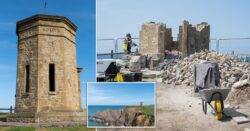A huge fundraiser was launched to fund the mammoth move (Picture: SWNS)
An historic coastal lookout tower is being moved inland brick by brick – to protect it from falling into the sea.
The 188-year-old coastguard’s tower in Bude, Cornwall is being relocated 100m to save it from coastal erosion.
Locals had banded together to raise as much money as possible for the ambitious project.
The landmark was at risk of falling into the water below unless action was taken in the coming years.
The moving of the Bude Tower in progress (Picture: SWNS)
Mick Robson on the construction site of the project(Picture: SWNS)
£57,801 was raised in the Save Our Storm Tower fundraiser over the course of 56 days.
Organisers issued a rallying call for help after posting: ‘The Storm Tower is in serious danger due to ongoing coastal erosion of the Compass Point cliffs below, if left untouched the elements will claim the tower and this local landmark will be lost forever.’
Local companies had got in touch to offer vouchers and freebies to help attract donations.
So much was raised, that an additional aim was decided on – to launch an interactive heritage exhibition at The Castle, Bude about the Storm Tower.
Built from sandstone and shale is has saved the lives of countless sailors over the past two centuries.(Picture: SWNS)
The Compass Point Project fundraiser collected more than £50,000 (Picture: SWNS)
The Grade II-listed tower Compass Point Storm Tower – known as the Pepperpot – sits on a clifftop near Bude overlooking the Atlantic.
Built from sandstone and shale is has saved the lives of countless sailors over the past two centuries.
Designed by George Wightwick the tower has eight sides that map the points of a compass.
A coastguard would sit inside during high tides and storms and use a flagpole to alert ships.
Funnily enough, the brick-by-brick massive move isn’t unique. The tower was previously relocated in 1881 for the same reason.
The history of the Storm Tower
The Bude Pepperpot(Picture: SWNS)
The following information, from the Save Compass Point Crowdfunder, details the fastincating history of the tower.
An historical icon of Bude, the Storm Tower sits on overwatch proudly above Bude Bay.
Originally designed by architect, George Wightwick, in 1835 for Sir Thomas Acland, as a refuge for the coastguard and for ornamental purposes.
This iconic octagonal tower was modelled by Wightwick on the ‘Temple of the Winds’ at Athens, and stands on a plinth with three granite steps leading up to the entrance on the east side with points of the compass carved into the structure.
With constant coastal erosion taking place at Compass Point, it was only a matter of time before the Storm Tower would need to be relocated.
Originally moved inland to its current position in 1881, 140 years later the Storm Tower is again teetering on the edge of the cliff, exposed to the perils of the sea below. Its future existence remains uncertain unless sufficient funding can be raised to move the building inland once again.
First registered as a Grade II listed building in 1985, extensive work started last year with the completion of the Heritage Impact Assessment, arranged by Bude-Stratton Town Council and funded by Cornwall Council.
This outlined suitable options for the safe movement of the Storm Tower inland by approximately 100 meters. Part of Efford Down, the land upon which the Storm Tower sits, and indeed the building itself, is leased to Cornwall Council on a 500-year term.
On Thursday January 14, 2021, Bude-Stratton Town Council voted unanimously in favour of supporting The Compass Point Project.
Get in touch with our news team by emailing us at [email protected].
For more stories like this, check our news page.
The 188-year-old coastguard’s tower in Bude, Cornwall is being relocated 100m to save it from coastal erosion.





